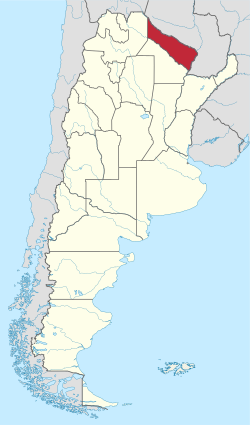Formosa Province
| Basic data | |
|---|---|
 ( Details ) |
 ( Details ) |
| Capital: | Formosa |
| Surface:
- Total |
Rank 19 of 24 72,066 km² |
|
Population :
- Total 2010 |
Rank 17 out of 24
530,162 inhabitants |
| ISO 3166-2 code: | AR-P |
| politics | |
| Region : | Región Noreste Argentino |
| Structure: | 9 departments |
| Gobernador: | Gildo Insfrán |
| Website of the Formosa Province | |
Formosa is a province in northeast Argentina that geographically belongs to the Gran Chaco region . Formosa borders Paraguay to the north and east . The north-eastern tip is opposite the Paraguayan capital Asunción . Formosa borders the Province of Salta to the west and the Province of Chaco to the south . The provincial capital is also called Formosa .
Geography and climate
The entire territory of the province is flat. The climate is subtropical with hot, humid summers and dry, warm winters. In the west of the province you can find the Impenetrable , an impenetrable thorn bush forest.
population
Much of the population lives in the eastern third of the province, which has a more humid and less harsh climate than the west. The largest cities are the provincial capital Formosa with 210,000 inhabitants, the border town Clorinda with 50,000 and Pirané with 35,000 inhabitants.
A large proportion (approx. 50%) of the population consists of mestizos . There are also numerous traditionally living groups of indigenous peoples, among which the Wichi or Matacos as well as the Toba and the Pilagá are the most numerous, followed by the Chiriguano and the Chané in the west.
History and politics
Formosa was part of Paraguay until the lost Triple Alliance War (1865–70). At the end of the 19th century there were repeated disputes between Argentina and Paraguay about the affiliation with Formosa. The US President Hayes as arbitrator decided While in 1878 in favor of Paraguay, but Argentina refused to return the territory. Today's Formosa was created in 1884 from the division of the Chaco territory into Chaco and Formosa. It was not until June 28, 1955, that the territory was raised to a province.
Politically, Formosa is one of the most backward provinces in Argentina. Democracy has been severely weakened and the provincial government must be accused of using the many illiterate people to fraudulent elections and of making social assistance dependent on the political stance of the recipients. Gildo Insfrán (PJ) has been the head of government since 1995 .
Administrative division
The provincial constitution of 1957 (reformed in 1991 and 2003) provides for the division of the province into nine departments (counties). The departments in turn consist of municipalities ( Municipios ), Comisiones de Fomento and Juntas Vecinales Provinciales. Municipality or municipality may call themselves settlements with more than 1,000 inhabitants. The municipalities of the province are divided into three categories: Municipios of the first category are the municipalities with 30,000 and more inhabitants, Municipios of the second category are those with a population between 5,000 and 29,999 and Municipios of the third category must have between 1,000 and 4,999 inhabitants. A Comisión de Fomento needs at least 500 inhabitants. A Junta Vecinal Provincial represents settlements with less than 500 inhabitants. It is administratively assigned to a municipality.
| Department | Capital | Area in km² | Population (2010) |
| Bermejo | Laguna Yema | 12,850 | 14,046 |
| Formosa | Formosa | 6,195 | 234.354 |
| Laishí | Misión San Francisco de Laishí | 3,480 | 17,063 |
| Matacos | Ingeniero Juarez | 4,431 | 14,375 |
| Patiño | Comandante Fontana | 24,502 | 68,581 |
| Pilagás | El Espinillo | 3,041 | 18,399 |
| Pilcomayo | Clorinda | 5,342 | 85.024 |
| Pirane | Pirane | 8,425 | 64,566 |
| Ramón Lista | General Mosconi | 3,800 | 13,754 |
economy
The timber industry, and to a lesser extent agriculture and livestock , has always been the main contributor to the province's economic strength, which is far below average. About 60% of the population lives on state welfare , there is a high poverty rate (65%, average: 45%). Smuggling also plays a major role in the northeast of the province and especially in the border town of Clorinda.
tourism
The biggest tourist attraction is the Río Pilcomayo National Park in the north of the province, which protects part of the Chaco plain and has a rich fauna (including jaguars , pumas , turtles and snakes ).
Provincial Anthem
Armando de Vita y Lacerra wrote the lyrics for the Anthem of the Province of Formosa and Víctor Rival wrote the melody. Marcha a Formosa was sung for the first time on April 8, 1955, and in 1964 it was officially recognized as an anthem. In 1988 schools were required by decree to teach the hymn and its story to students of all ages. Apart from that, according to decree 1467, the hymn must be played on all official occasions in the province.
Web links
- Formosa Provincial Administration Portal (Spanish)
Individual evidence
Coordinates: 25 ° 0 ′ S , 60 ° 0 ′ W


